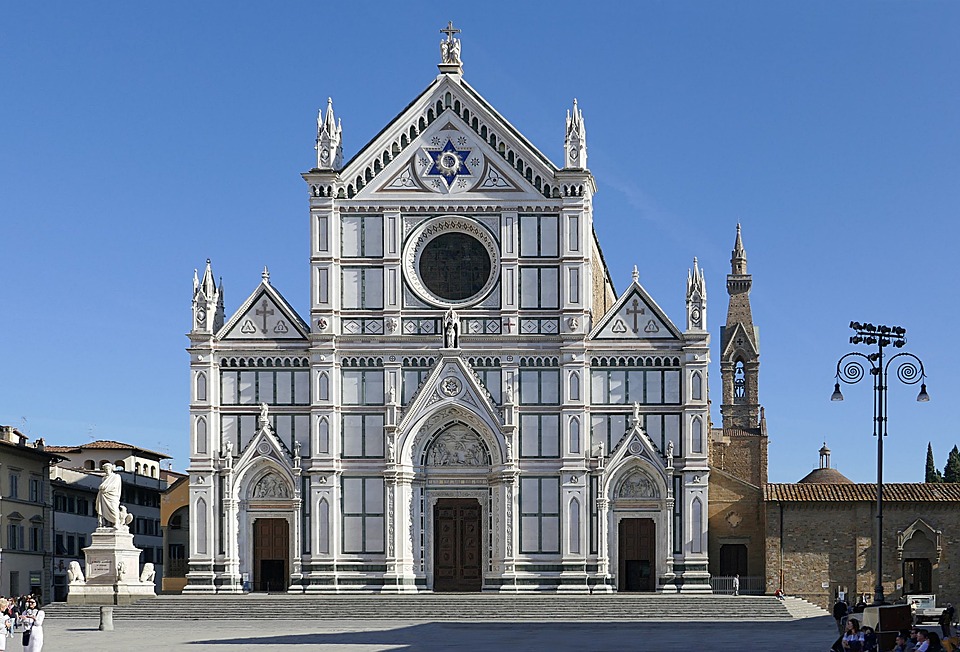back

The Basilica di Santa Croce (Basilica of the Holy Cross) is the principal Franciscan church in Florence, Italy, and a minor basilica of the Roman Catholic Church. It is situated on the Piazza di Santa Croce, about 800 meters south-east of the Duomo. The site, when first chosen, was in marshland outside the city walls. It is the burial place of some of the most illustrious Italians, such as Michelangelo, Galileo, Machiavelli, the poet Foscolo, the philosopher Gentile and the composer Rossini, thus it is known also as the Temple of the Italian Glories.
The Basilica is the largest Franciscan church in the world. Its most notable features are its sixteen chapels, many of them decorated with frescoes by Giotto and his pupils,[a] and its tombs and cenotaphs. Legend says that Santa Croce was founded by St Francis himself. The construction of the current church, to replace an older building, was begun on 12 May 1294, possibly by Arnolfo di Cambio, and paid for by some of the city's wealthiest families. It was consecrated in 1442 by Pope Eugene IV. The building's design reflects the austere approach of the Franciscans. The floorplan is an Egyptian or Tau cross (a symbol of St Francis), 115 metres in length with a nave and two aisles separated by lines of octagonal columns. To the south of the church was a convent, some of whose buildings remain.
The Primo Chiostro, the main cloister, houses the Cappella dei Pazzi, built as the chapter house, completed in the 1470s. Filippo Brunelleschi (who had designed and executed the dome of the Duomo) was involved in its design which has remained rigorously simple and unadorned.
In 1560, the choir screen was removed as part of changes arising from the Counter-Reformation and the interior rebuilt by Giorgio Vasari. As a result, there was damage to the church's decoration and most of the altars previously located on the screen were lost. At the behest of Cosimo I, Vasari plastered over Giotto's frescoes and placed some new altars.
The bell tower was built in 1842, replacing an earlier one damaged by lightning. The neo-Gothic marble façade dates from 1857-1863. The Jewish architect Niccolo Matas from Ancona, designed the church's façade, working a prominent Star of David into the composition. Matas had wanted to be buried with his peers but because he was Jewish, he was buried under the threshold and honored with an inscription.
In 1866, the complex became public property, as a part of government suppression of most religious houses, following the wars that gained Italian independence and unity.
The Museo dell'Opera di Santa Croce is housed mainly in the refectory, also off the cloister. A monument to Florence Nightingale stands in the cloister, in the city in which she was born and after which she was named. Brunelleschi also built the inner cloister, completed in 1453.
In 1940, during the safe hiding of various works during World War II, Ugo Procacci noticed the Badia Polyptych being carried out of the church. He reasoned that this had been removed from the Badia Fiorentina during the Napoleonic occupation and accidentally re-installed in Santa Croce. Between 1958 and 1961, Leonetto Tintori removed layers of whitewash and overpaint from Giotto's Peruzzi Chapel scenes to reveal his original work.
In 1966, the Arno River flooded much of Florence, including Santa Croce. The water entered the church bringing mud, pollution and heating oil. The damage to buildings and art treasures was severe, taking several decades to repair.
Today the former dormitory of the Franciscan friars houses the Scuola del Cuoio (Leather School). Visitors can watch as artisans craft purses, wallets, and other leather goods which are sold in the adjacent shop.
The basilica has been undergoing a multi-year restoration program with assistance from Italy’s civil protection agency. On 20 October 2017, the property was closed to visitors due to falling masonry which caused the death of a tourist from Spain. The basilica was closed temporarily during a survey of the stability of the church. The Italian Ministry of Culture said that "there will be an investigation by magistrates to understand how this dramatic fact happened and whether there are responsibilities over maintenance.